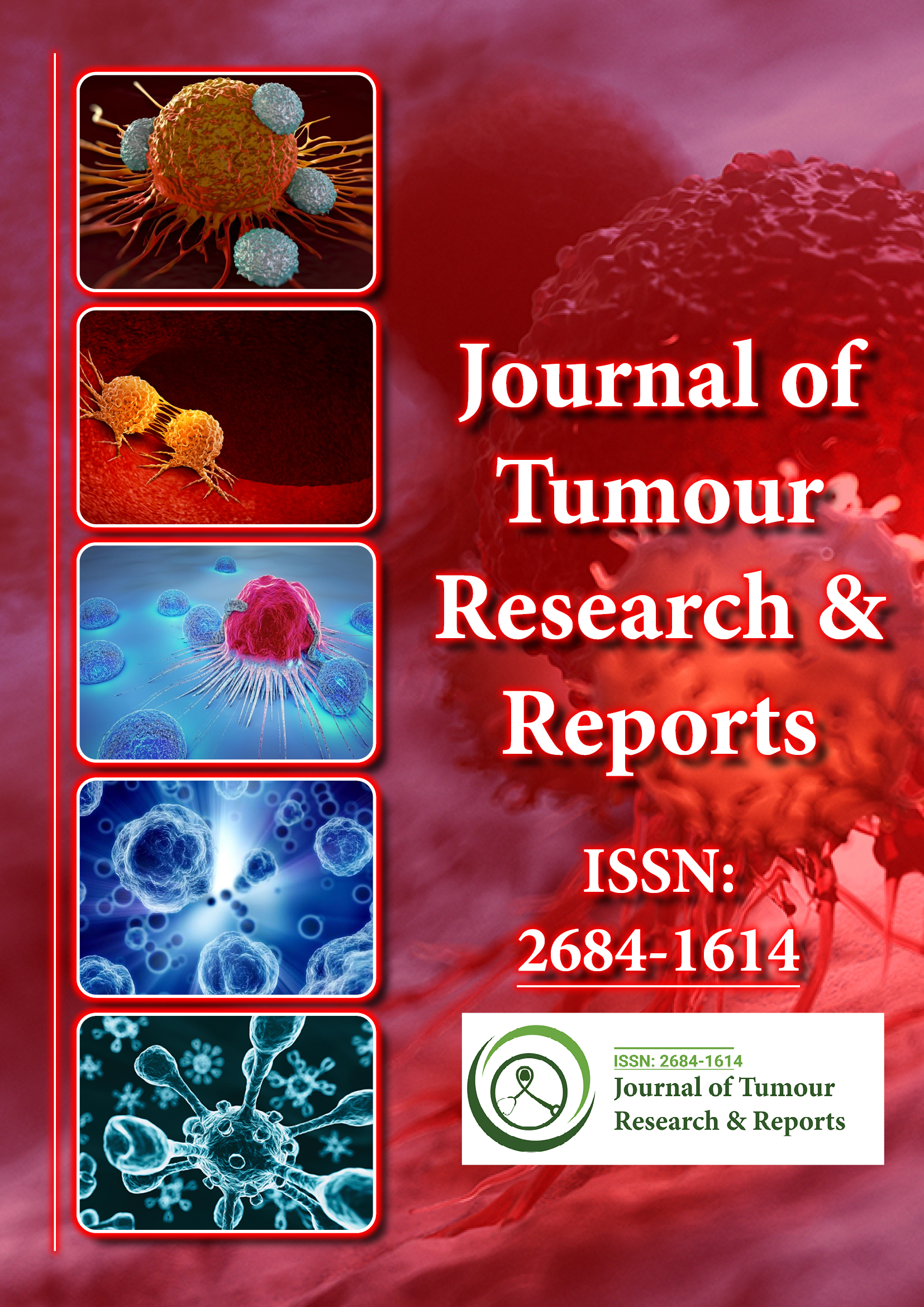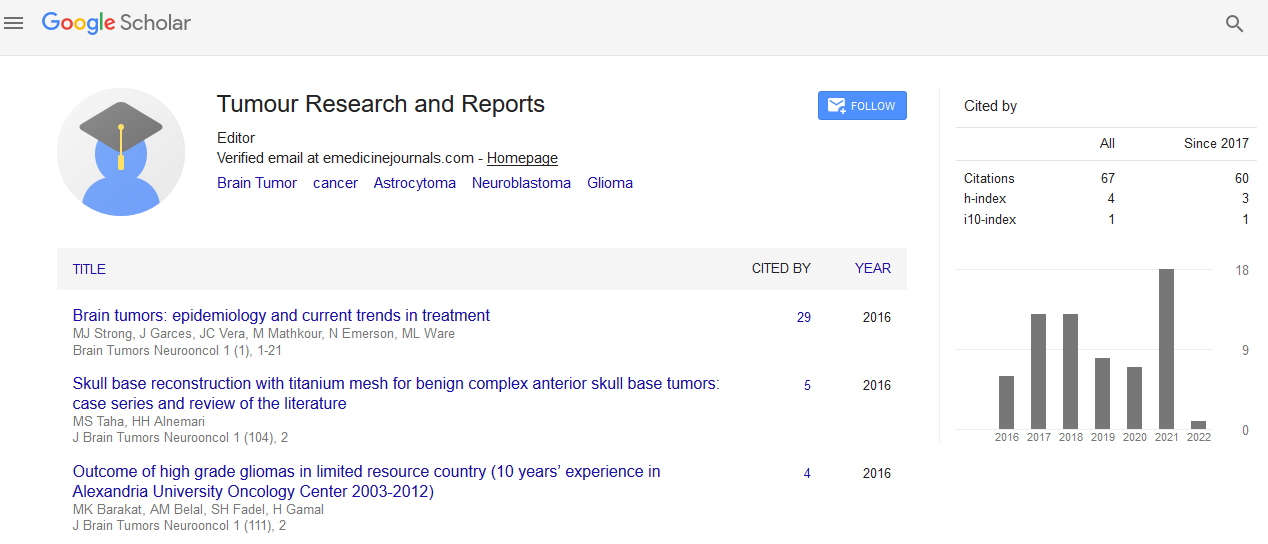Indexed In
- RefSeek
- Hamdard University
- EBSCO A-Z
- Google Scholar
Useful Links
Share This Page
Journal Flyer

Open Access Journals
- Agri and Aquaculture
- Biochemistry
- Bioinformatics & Systems Biology
- Business & Management
- Chemistry
- Clinical Sciences
- Engineering
- Food & Nutrition
- General Science
- Genetics & Molecular Biology
- Immunology & Microbiology
- Medical Sciences
- Neuroscience & Psychology
- Nursing & Health Care
- Pharmaceutical Sciences
Opinion Article - (2023) Volume 8, Issue 1
Role of Obesity and Estrogen Levels in Endometrial Cancer
Michael Sandra*Received: 01-Mar-2023, Manuscript No. JTRR-23-20758; Editor assigned: 06-Mar-2023, Pre QC No. JTRR-23-20758 (PQ); Reviewed: 28-Mar-2023, QC No. JTRR-23-20758; Revised: 28-Mar-2023, Manuscript No. JTRR-23-20758 (R); Published: 05-Apr-2023, DOI: 10.35248/2684-1614.23.8.186
Description
The most prevalent gynecologic cancer is endometrial cancer, which accounts for 3.5% of all new cancer cases. The incidence of Endometrial Cancer (EC) rose by 0.7% between 1999 and 2015, and associated mortality increased by 1.1% between 1999 and 2016. This rise is due to an increase in feminine life expectancy as well as an increase in the prevalence of obesity. The 5-year relative survival rate for localised EC is 94.9%, compared to 69.3% for more severe instances of regional EC. EC recurs in about 13% of high-risk individuals and is linked to a poor prognosis.
EC is broadly divided into two types: endometriosis and non-endometriosis. Type I ECs are estrogen-dependent, have a lower proliferative potential, and are associated with a better prognosis and lower recurrence rates compared to type II. Anovulation, excess adipose tissue, and/or excess estrogen exposure from non- progesterone hormone therapy predisposes a woman to her type I EC. Conversely, the etiology of type II EC is estrogen- independent and tumors have a high metastatic potential, worsening patient prognosis and increasing cancer recurrence. Regardless of type, EC tumors are composed of heterogeneous cell subpopulations with different growth characteristics and therapeutic sensitivities. Heterogeneous tumors are composed of cancer progenitor cells and Cancer Stem Cells (CSCs). CSCs are responsible for tumorigenesis and lead to cancer recurrence even after long-term remission. CSCs exhibit characteristic properties of stem cells, such as their ability to self-renew and differentiate into progenitor cells. These cells imaginatively exploit the microenvironment to enter a quiescent state characterized by cell cycle arrest, resulting in therapeutic resistance and immune evasion. Endogenous cues within cancer cells are important for tumor progression. However, cancer cell survival also depends on its microenvironment. Especially in ECs, the tumor microenvironment supports cancer cells through contact- dependent and contact-independent interactions to increase metastatic potential.
Types of endometrial cancer
The Bokhman dualistic paradigm divides EC into two categories of pathogenicity. The most typical type of EC, type I tumors, are progesterone-sensitive, oestrogen-dependent, and frequently show premalignant endometrial hypertrophy. Type II tumours develop in the uterus, are oestrogen-independent, and originate from precancerous lesions. Type II EC manifests sooner and more strongly, is insensitive to progestogens, and is frequently resistant to conventional radiation and chemotherapy. As a result, type II EC is significantly more malignant than type I EC, and diagnosis is linked to a bad prognosis.
Endometrioid histology is the norm, whereas the majority of type II ECs has histologies other than endometrioid, like serous carcinoma and clear cell carcinoma. However, classification based on histology alone can be imprecise due to overlap of different histologic morphologies, so molecular markers identified by immunohistochemistry are often diagnostic.
Role of obesity in EC pathogenesis
EC rates in high-income countries like the United States of America have risen over the past decades, as have obesity rates. The incidence of EC is directly related to obesity. An increase in BMI of 5 increases the risk of EC by 50%. Most ECs are associated with obesity because androgens are converted to estrogens by aromatase in adipocytes, resulting in an excess of freely circulating estrogen. The administration of progestogens to estrogens has been associated with women desiring pregnancy. Specific strategies for treating type I EC. In fact, patients with stage IA (low-grade progesterone receptor-positive) endometrioid tumors who are interested in having children have been shown to have excellent clinical outcomes, including pregnancy, when treated with progestin.
During the female menstrual period, the ovarian steroid hormones estradiol and progesterone are the primary factors causing the cyclic proliferation, differentiation, and shedding of the endometrium (menstruation). The menstrual period is divided into three phases: follicular, ovulatory, and luteal. During the follicular period, the granulosa cells of the follicle produce more estradiol, which stimulates the growth of endometrial epithelial and stromal cells.
Ovulation is stimulated by a mid-cycle increase of Luteinizing Hormone (LH) and Follicle-Stimulating Hormone (FSH) from the pituitary gland. The luteal phase starts after ovulation.
Citation: Sandra M (2023) Role of Obesity and Estrogen Levels in Endometrial Cancer. J Tum Res Reports. 8:186.
Copyright: © 2023 Sandra M. This is an open-access article distributed under the terms of the Creative Commons Attribution License, which permits unrestricted use, distribution, and reproduction in any medium, provided the original author and source are credited.

